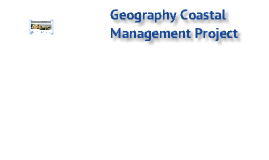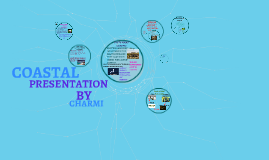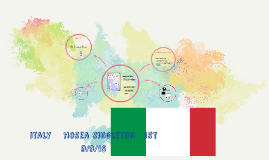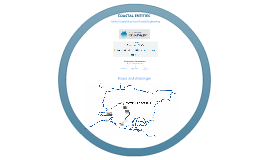Coastal Processes Presentation
Transcript: As is indicated in the diagram and video, the key landforms seen at erosional coasts include: Wavecut platforms; Blowholes; Beaches; Bays; Seacaves; Natural bridges; Headlands; and, Seastacks. Characteristics of Waves at Erosional Coasts There are three main types of waves. They are: - Spilling waves These waves break far from the shoreline. They are characterised by white foam rolling over the front of the wave and up the gentle beaches onto which they break. Consequently, they are ideal waves for body surfing. - Plunging waves These waves break on moderately sloped beaches. They consist of the tubes which are popular amongst surfers. - Surging waves Surging waves occur on steep beaches. They are the main cause of erosion and roll up the beach instead of breaking onto it. Coastal Erosion has a major impact on Depositional Coasts, as moving tides and coastal processes such as the Pacific Ocean currents. Diagrams above show how Sediment is pushed up/down coasts and river mouths through longshore drift to cause Sand Spits, Barrier Islands, Tombolos, Berms and Runnels. Formations Sea caves formed by erosion gradually grow upwards as the waves hit the rock. Once they erode to the surface, the water is blasted into the air. Deconstructive waves A form of erosion when rocks and other particles that are being transported by the current make impact with the bed and bed grains, causing break up of rocks. This break up makes the rocks smoother and rounder. Corrasion (abrasion) Water has enter a crack in this rock, causing erosion and expansion of the crack Blowhole and Cave Headland Beach Backwash - The motion of receding waves Swash - rush of water up the beach after breaking of a wave An arch occurs when two caves on a headland, formed by erosion, break through making a tunnel. When the pressure from above is too great, this collapses, forming a stack of rock on the side not attached to land. Sand is formed by the abrasion of rocks by waves, and this is deposited, again by waves, onto the shore, forming beaches. Long-shore drift transports the sand and pebble along the shore. Hydraulic Action Wave-Cut Platform YouTube Video: What is coastal erosion? Here, the rocks are being flung against the rock by waves, causing abrasion. Deposit eroded material Low energy and add to the beach Erosion from waves causes soft rocks to be broken up much faster than hard rocks, causing headlands and bays to form, over thousands of years Christian, Giacomo, Lachlan, Michael Waves are formed by the action of waves blowing across the ocean. They first form ripples which form wavelets which then form waves. In the open ocean a swell forms. As waves travel towards the coast they take the natural wind energy with them. The wave speed and size are influenced by the strength of the wind and the length of the fetch. Fetch is the distance the wind travels over the ocean to form the wave. As waves enter shallow water the energy in the waves begins to interact with the sea floor thus decreasing its speed, shortens its wave length and increases its height. Eventually the wave peak travels faster than the base of the wave, causing it to break and release the contained energy. The broken wave forms the surf and swash zone. The action of salt on minerals like iron (contained in rock), which weakens the rock and makes it susceptible to erosion. Tombolo Here, attrition has caused the bed to become uneven. Constructive waves Erosion Formed when long-shore drift moves sediment across a coast, blocking patches of water if the coastline is concave. Waves A tombolo is essentially a spit that is formed between two landmasses, forming a bridge. The End! The act of waves crashing on rocks, which moves rocks and other material. This breaks it the material into small pieces, which makes contact with the rock shelf, eroding it. Strong seasonal wind causes the waves to often hit the coast at oblique angles. This causes the waves to run up sand formations at slight angles, yet retract normally perpendicular to the beach due to gravity, this is a slight push that causes longshore drift. Thank-you for Watching Attrition Corrosion from waves on cliff causes undercutting, which eventually collapses to form a platform Spit Typical Landforms at Erosional Coasts Stack and Arch Sand dunes are formed when wind blows sand up on mound where it grows. The sand beyond this mound slips down, forming the distinct shape. Waves make the dune more distinguishable. Aeolian Transport Parts of a wave Depositional Coasts This diagram shows the chemical process. The solution is water and air, and the metal is rock. M is salt acting on ne, the mineral (e.g. iron) Waves and Coasts Breakdown rock, remove sand Create steep beaches Processes Coastal Lagoon Formations Material is moved along the coastline by long-shore drift. The material is deposited to form a spit Coastal Sand Dune Corrosion When waves enter cracks in rocks, which leads to air being compressed by the force of the water.

















